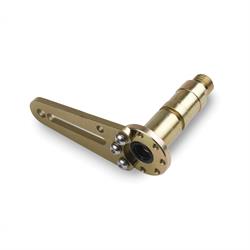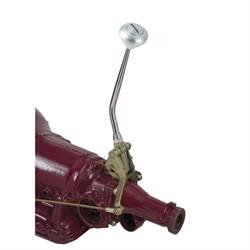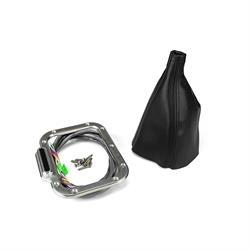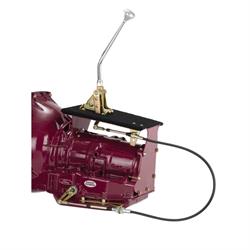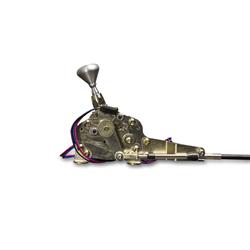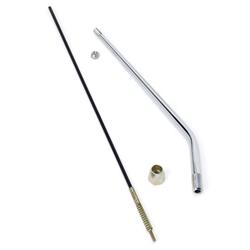Two Pedal Tech: Finding the Best Automatic Shifter for Your Build
Is An Automatic Floor Shifter Right For You?
The old adage states that real performance cars must have three pedals. While we certainly enjoy a manual gear box and rowing through the gears, especially on a road course, there are many good reasons to run an automatic in your classic muscle car, pickup truck, or hot rod project. One really good reason for many is the muscles in your left leg. Heavy clutches with mechanical linkages aren’t the easiest to manipulate when you’re dealing with age-related issues like arthritis and bone ailments. We’re not getting any younger, and sometimes the best choice is an automatic transmission to be able to still enjoy this great hobby.
On a more positive note, running an automatic transmission has several other great benefits, including usually being more efficient and consistent when it comes to drag racing. Let’s not forget that special someone too. For the family cruiser/fun car we’d much rather stick the shifter in Drive (or Overdrive!) and have a free hand to hold theirs, share a milkshake with, or just enjoy the drive without having to continually grab the shifter for upshifts and downshifts. And if you really want to impress your friends at the cruise night by grabbing a gear and chirping the tires the automatic can still do that too!
So, you know you’re keeping or building your project with an automatic transmission, but the real question becomes what type of shifter I want to install and what features do I need in my shifter purchase. Well, you’ve come to the right place, as we’ll provide plenty of information in the following sections on shifter designs, features to look for, and types of installation options available. Best of all, everything you’ll need to get your automatic transmission shifter installed can be found right here at Speedway Motors.
Floor Shifter vs Column Shifter
While it is rare to find a column shifted vehicle for sale on a dealer lot these days, the column shift automatic was, at one point, the predominant offering from automobile manufacturers. In the early 60s, small sporty cars, such as the Mustang, Camaro, and others began offering a floor shift automatic (often with a console and bucket seats to enhance the sporty image of the cars) that has become pretty much the standard now.
The column shift provided additional seating up front (most cars back then used a bench front seat for three-across seating) by freeing up the transmission tunnel area for leg room. The column shift, like the original floor shift, used a mechanical rod linkage to shift the transmission. This can often be a head scratcher to figure out when doing a modern engine and/or trans swap, but aftermarket steering columns with integral shifter and heim joint linkage kits still allow a column shift to work with just about any combination of engine and transmission these days if that’s the route you wish to go.
That said, we’re going to focus our efforts of this guide on the typical floor shift applications. Either upgrading the factory automatic floor shifter or converting from column shift to floor shift (popular in trucks), there are many different shifter styles, mounting options, and more to consider. About the only detriment to going the floor shift location is losing that capacity to have an extra passenger up front or a bench seat, though some floor shifters are compact enough, or allow a bench seat shift lever to be added for clearance, so honestly, there’s very little reason not to go the floor shift route these days.
What Automatic Floor Shifter Style is Best?
So, you’ve decided to update your existing/factory floor shifter, or you wish to convert your old column shift truck or classic car to a floor shift configuration. Great! You’ll love the way a floor shift automatic gives you more precise control over your automatic’s gear changes and the floor shifter just screams performance as well. That said, you have a lot to consider when it comes to not only the outward styling of your floor shifter, but also its shifting functionality. There are several unique styles of floor shifters and often you can find a similar look or model of shifter in different shifter styles. Let’s break down the most popular versions and how they work, whether you need a Turbo 350 shifter or a floor shifter for 700R4 transmissions.
Top Detent Shifter
The top detent shifter gets its name from the fact the gear position detents are on the top of the shifter’s internal mechanism. The top detent shifter often will use either a push button knob on top (like most Lokar shifters or the side of a T-handle (many factory style shifters) or some form of finger lever/T-trigger attached to the shifter lever itself. There are a few models where the whole knob and lever must be pulled upwards, like this B&M shifter model. Top detent shifters are popular in console applications, both aftermarket and OEM consoles, and often used with a remote gear indicator and a manual transmission-look shift boot.
Side Detent Shifter
Where the side detent shifter differs from the popular top detent shifter is in where the detent is located and how it affects the shifter lever. Where a top detent shifter’s shift gate plate is mounted vertically on the side of the shifter body and requires the shifter lock pawl to move up and down via rod or cable (what’s connected to the shifter trigger or the button in the shift knob) the side detent shifter’s gate plate is mounted horizontally in the base of the shifter assembly. Moving the lock pawl through the gates requires the shifter lever to be moved towards the driver for the shifter lever to pass from one gate to the next. A side detent shifter still utilizes the same safety lock out of Park and Reverse, but the shifter lever itself is what changes the gears versus a trigger lever or push button. Like the top detent shifters, side detent shifters can often be hidden within a stock or aftermarket console with a shift boot. Many electronic instrument clusters now provide for gear indication if you feel that is important as well.
Gated Shifter
Many ask what is a gated shifter? The gated shifter automatic is like a side detent shifter, but the shift gate is engineered into the shifter top cover versus the base of the shifter. This provides a visual and tactile confirmation as to what gear is selected and helps with safely keeping Reverse or the wrong forward gear from being selected while upshifting during performance driving. The shifter itself is often just a mounting base with pivoting lever, so without the shifter cover there is no positive detent or stop for each gear, thus the shifter cover is mandatory for safe use and something to consider when installing for looks, clearance, console fit, etc. and usually cannot be integrated into a stock-looking interior since the shifter cover is a critical part of the gate operation.
Reverse Pattern Shifter
For those with reverse pattern valve bodies in their automatic transmissions a standard shifter will certainly work, but your gear selection and gate lockout for forward gears will be backwards. Standard transmission gear indicators are typically P-R-N-D-2-1, or P-R-N-3-2-1, whereas a reverse pattern valve body shifts P-R-N-1-2-3. Many shifter brands offer a reverse pattern top detent gate plate kit with updated gear selector decal or indicator window for proper shifter operation with a reverse pattern valve body. Other brands offer both standard and reverse pattern capabilities right out of the box, so be sure to read the full specs and features of the shifter you are considering for your project.
How Do You Mount a Floor Shifter?
Automatic floor shifters are made up of a steel base plate that provides a surface for the shifter cable, shifter lever, and any gate plates to attach to. These bases often feature fixed mounting holes to attach the shifter base to the vehicle’s tunnel. Some shifter brands, like the Lokar automatic floor shifter, provide adjustable mounting tabs that can be clocked/rotated to provide specific mounting solutions, including the option of mounting on top of the transmission tunnel sheetmetal, or from below it. Additionally, many shifters allow direct transmission mounting, either on the main case or the tailshaft area. Each of these mounting options are outlined in greater detail below.
Floor Top Mount
Most of the automatic shifters available, no matter the type of gate mechanism, are going to be a floor mount that bolts to the top of the transmission tunnel. Installation usually requires nothing more than drilling holes for the attaching hardware and the shifter cable pass through. A top mount shifter has none of the shifter body inside the transmission tunnel (except for the shift arm itself), which provides maximum clearance for large-bodied transmissions. However, with the full body of the shifter sitting on top of the floor, the shifter is a much more prominent piece of the interior. Top mount shifters are available in shift linkage rod and cable operated versions.
Floor Bottom Mount
Some floor mount shifters offer the option of being bottom mounted to your transmission tunnel, like the Lokar automatic floor shifter. This style of mounting usually requires relocating adjustable mounting ears or installing additional brackets or spacers. Mounting the floor shifter beneath the transmission tunnel lowers the overall profile of the shifter inside the vehicle and often allows the use of factory consoles to still be used over the aftermarket shifter. The only caveat with bottom mounting your floor shifter is that there needs to be sufficient clearance between the shifter assembly and your transmission case.
Transmission Case Mount
Having the shifter assembly mounted directly to the transmission case removes any issues of shifter linkage misalignment between the shifter and the transmission’s manual shift lever because they are essentially “one” with the shifter bolted directly on the case. Of course, you need to have enough transmission tunnel clearance for the adjustable mounting brackets and the main body of the shifter itself. Case mount shifters are an excellent choice for fiberglass bodied cars where the floor structure may not be strong enough to support the continued movement of a shifter mounted to it.
Transmission Tailshaft Mount
The tailshaft mounted shifter is essentially like the case mounted shifter just described, only with a smaller bracket assembly tied in to the mounting plane of the tailshaft housing to the main transmission case, placing the shifter further back. The tailshaft mounted shifter has been popular for ’32-’34 Fords and other small cars with fiberglass bodies as well.
Cable Shifter vs Rod Shifter?
Many OEM automatic floor shifters used a shift linkage rod up through the late 1970s. The rods used in these stock applications were bent and formed to clear the factory exhaust and under structure and usually utilized rubber or plastic bushings at each end. There are still some shifters that use a linkage rod setup, but now incorporate heim ends for smoother shifting and custom adjustability. You will often see shift linkage rods used with case mounted or tailshaft mounted shifters, as the shifter to transmission shift lever relationship does not change with driveline or body twist. For transmission tunnel mounted shifters, a linkage rod is still certainly acceptable and when bent/routed properly offers plenty of clearance around all manner of under car obstacles while still providing a smooth and positive gear change. There are times where it may be a better choice to either convert to a cable shift setup or purchase a shifter that comes standard with a shifter cable. The cable allows an easier routing when the shifter is in line or forward of the transmission’s manual shift lever, such as in a mid-engine application.
What Shifter Works with Electronically Controlled Transmissions
So, you’ve decided to go full tilt boogie on your project with an LS crate engine and 4L80E transmission (or a Coyote and 6R80 for you Ford fans or a Gen3 Hemi and 850RE for you Mopar enthusiasts) and wondering just how to shift your new fangled electronically controlled transmission. Any of these modern multi-gear electronic wonders will either require an engine management system with transmission control, or a stand alone transmission control system to properly control the upshifts in forward gears. However, you still need an automatic floor shifter to manually engage Park, Reverse, Neutral, and forward gears.
Standard Floor Shifter (no electronic shifting option)
Most electronically controlled automatics will function just fine with your typical floor mount cable operated shifter that has the proper top or side detent gates. For example, the popular Ford 4R70W has OD, D, and 1 (low) forward gear detents. This means that any standard “3-speed” automatic shifter will work for this electronic transmission, you will just not have any manual control over the electronic portion of the transmission.
Factory Shifter Retrofit
While this does take some skill and fabrication, along with understanding the shifter’s wiring harness, some people have integrated the factory 4-, 6-, 8-, or 10-speed automatic shifter along with a modern vehicle’s drivetrain swap. This is often the best option for the newer multi-speed transmissions because aftermarket transmission controllers do not support these transmissions just yet. So, if you’ve found a deal on a wrecked Hemi with 8-speed automatic or a Mustang GT with Coyote and a 10-speed, the stock shifter might be your best bet here if you’re willing to put in the effort.
Lokar Sport Shifter
A great option for many electronically controlled automatic transmissions is the Lokar Electronic Sport Mode Shifter. Available for popular 4- and 6-speed GM and Ford automatic transmissions, the shifter provides the manual gear selection required to select Park, Reverse, Neutral, and forward gears, with a separate gate for electronic up and down shifts commanded via micro switches built into the shifter. This unit works great with any transmission controller that has manual upshift and downshift inputs and is one of the more popular 4L80E shifter options.
Paddle Shifters
A rather unique option for those looking to do something a little different would be a paddle shifter conversion. We offer the TCI paddle shifter system for GM 4- and 6-speed automatics. This unique solution is driven by TCI’s EZ-TCU controller for forward gear changes. You’ll still need a traditional floor shifter to engage Park, Reverse, and Neutral. But once in Drive you can manually command up and down shifts with fingertip ease. We also offer the paddle shifter system with a gear indicator display as well.
Are There Shifter Accessories That Will Help My Installation?
By this point we hope you have thought through your shifter choices and fitment needs and are ready to get to work on your new floor shifter installation. But take a breath before you grab that drill and consider a few additional items to your cart to make your new floor shifter all it can be.
Shift Levers
Many floor shifters have replaceable shift levers, like the vast line of shifter models from Lokar. This allows you to find the perfect shifting position for your driving comfort or interior needs. From double bend shifters to clear bench seats to straight levers for muscle car console installations, there are numerous options available.
Shift Knobs/Handles
There’s no better way to personalize that fresh shifter install than with a great looking and feeling shift knob or T-handle. Most shifters come with a basic knob that can be unthreaded and a custom knob installed to personalize your ride. From the classic cue ball to something a bit more interesting like a helmet wearing skull perhaps, there is a shift knob or handle for every theme.
Shift Boots/Trim
While most floor shifters feature a trimmable plastic housing, there are numerous shifters that are designed to utilize a shifter boot and trim ring, such as the line of shifters from Lokar. Often you can remove the plastic housing and cover the shifter with a boot and trim ring as well. This offers the look of a manual transmission shifter and is an easy way to dress up a shifter with a plastic housing. You’ll find round and square trim rings with matching vinyl boots. Or have your upholstery shop make a matching boot to your door or seat trim and secure with a trim ring of your choice.
Gear Indicators
Generally speaking, floor shifters use an illuminated window, a shift gate decal, or shift gate pattern right on the shifter knob to indicate gear placement. Alternatively, you can use a gear indicator that can be mounted in the dash, or part of the shift boot trim ring to show gear indication for a more custom look. We offer in-dash solutions from Lokar, Auto Meter, and others. For those who prefer the indicator to be on the shifter, Lokar’s line of shift indicator boot kits provides the perfect solution with billet trim with indicator in horizontal or vertical configurations, a shifter lever boot, and all mounting hardware.
Transmission Selector Shaft Arms
These are not always needed, but in some cases can be a huge help to get your new floor shifter to synchronize with the manual lever positions of your transmission. Often rebuilt transmissions are missing the factory selector shaft, or it is modified or even cut off. Available from Lokar for the Ford AOD/AOD-E/4R70W overdrive transmissions, the Ford C4 an C6 three-speed automatic transmissions, and GM Turbo 350 up to the 4L80E, these adjustable selector shafts make installation of your shift linkage or shifter cable a breeze.









